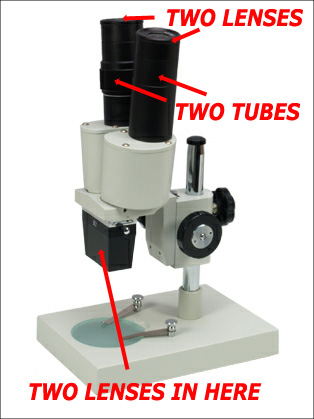|
Very young people find a stereo microscope a more rewarding and less frustrating microscope to use than a compound monocular microscope. Using a stereo means they can keep both eyes open. Most entry stereo microscopes have a magnification in the range of 10x to 40x which is more than enough to study all insects, and quite a few larger pond water creatures like brine shrimp and tiny water snails.
When looking through a binocular (2 eyes open but a non-3D flat image) or a stereo microscope (2 eyes open with a 3D image) for the first time, it often requires a bit of mental trickery to see just one circle of light instead of two. Most brains 'get it' and adjust very quickly. Very few people are unable to combine the two images. But sometimes
you have to know to kind of do that: combine the two images mentally, before your mind does it for you automatically.
When considering introducing a very young person, say- a 6 year old to the real world around them, so they can start to explore the tiny living forms which build the real world, either a stereo microscope... a fairly low powered one (10x or 20x) with good quality glass lenses, or a simple good quality magnifying glass is a simple and recommended option. Quality of the lens is important. The commercial world frequently offers the 'idea' of a microscope which does not deliver the desired
experience. When buying a microscope, you should consider a few critical facts to avoid disappointment. Read on...
|
|

Stereo Light Microscope |
